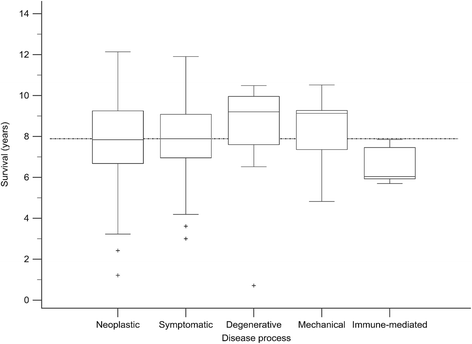Life expectancy and causes of death in Bernese mountain dogs in Switzerland
- PMID: 27457701
- PMCID: PMC4960675
- DOI: 10.1186/s12917-016-0782-9
Life expectancy and causes of death in Bernese mountain dogs in Switzerland
Abstract
Background: New regulations by the Swiss Federal Food Safety and Veterinary Office provide for the monitoring of breed health by Swiss breeding clubs. In collaboration with the Swiss Bernese Mountain Dog Club, the purpose of this study was to investigate the causes of death in purebred dogs registered by the club and born in 2001 and 2002.
Results: Of a total of 1290 Bernese mountain dogs (BMDs) born in 2001 and 2002 in Switzerland, data was collected from owners and veterinarians using a questionnaire designed for this study from 389 dogs (30.2 %). By the end of the study, 381/389 dogs (97.9 %) had died. The median life expectancy of all dogs was 8.4 years (IQR, 6.9-9.7). Female dogs had a significantly longer median survival (8.8 years; IQR, 7.1-10.3) than male dogs (7.7 years; IQR, 6.6-9.3) (P < 0.00). The cause of death was unknown in 89/381 dogs (23.4 %). For the remaining dogs, the most frequent causes of death were neoplasia (222/381, 58.3 %), degenerative joint disease (16/381, 4.2 %), spinal disorders (13/381, 3.4 %), renal injury (12/381, 3.1 %), and gastric or mesenteric volvulus (7/381, 1.8 %). However, large numbers of dogs were diagnosed with neoplasia without histopathologic or cytologic confirmation. Dogs with neoplasms had a shorter median survival than dogs with other disorders. The shortest median survival (6.8 years) was found for dogs with renal injury.
Conclusions: Findings of this study confirm a high prevalence of neoplasia and associated low life expectancy in BMDs. The results underline a need for more widespread precise diagnostics and further research on malignant tumours in this breed to improve overall breed health.
Keywords: Bernese mountain dog; Breed health; Canine; Life expectancy; Mortality; Neoplasia.
Figures




References
-
- Fleming JM, Creevy KE, Promislow DEL: Mortality in North American dogs from 1984 to An Investigation into age-, size-, and breed-related causes of death. J Vet Intern Med. 2004;2011(25):187–198. - PubMed
-
- Eichelberg H, Seine R. Lebenserwartung und Todesursachen bei Hunden I. Zur Situation bei Mischlingen und verschiedenen Rassehunden. Berliner und Münchner Tierärtzliche Wochenschrift. 1996;109:292–303. - PubMed
MeSH terms
LinkOut - more resources
Full Text Sources
Other Literature Sources

